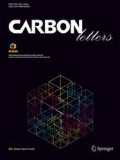Abstract
Plasma-sprayed HA coatings on metallic implants are widely used for clinical applications. However, typical lamellar structure along with plasma-sprayed coatings usually leads to weak inter-splat adhesion and impair their mechanical properties. In this research, graphene nanosheet (GNS) reinforced HA coatings were fabricated using plasma spray; these GNSs retained their original structure and distributed homogeneously in the as-sprayed coatings. On the basis of instrumented microindentation tests with and without multiple partial unloading, as compared with the monolithic HA coating, the inter-splat friction force increased by ~ 8.7% for the 1.0 wt% GNS/HA coating, and it slightly decreased to ~ 6.5% for the 2.0 wt% GNS/HA coating due to GNS agglomeration. Meanwhile, the added GNSs contributed greatly to the indentation yield strength of the HA coatings. These results illustrated that these embedded GNSs at splat boundaries are potential in splat-boundary strengthening and resisting splat sliding.




Similar content being viewed by others
References
Lahiri D, Ghosh S, Agarwal A (2012) Carbon nanotube reinforced hydroxyapatite composite for orthopedic application: a review. Mater Sci Eng C 32:1727. https://doi.org/10.1016/j.msec.2012.05.010
Gu YW, Loh NH, Khor KA, Tor SB, Cheng P (2002) Spark plasma sintering of hydroxyapatite powders. Biomaterials 23:37. https://doi.org/10.1016/S0142-9612(01)00076-X
Fu L, Khor KA, Lim JP (2001) Processing, microstructure and mechanical properties of yttria stabilized zirconia reinforced hydroxyapatite coatings. Mater Sci Eng A 316:46. https://doi.org/10.1016/S0921-5093(01)01253-9
Lima RS, Marple BR (2007) Thermal spray coatings engineered from nanostructured ceramic agglomerated powders for structural, thermal barrier and biomedical applications: a review. J Therm Spray Technol 16:40. https://doi.org/10.1007/s11666-006-9010-7
Yugeswaran S, Kobayashi A, Ucisik AH, Subramanian B (2015) Characterization of gas tunnel type plasma sprayed hydroxyapatite-nanostructure titania composite coatings. Appl Surf Sci 347:48. https://doi.org/10.1016/j.apsusc.2015.04.036
Chen Y, Gan C, Zhang TH, Yu G, Bai P, Kaplan A (2005) Laser-surface-alloyed carbon nanotubes reinforced hydroxyapatite composite coatings. Appl Phys Lett 86:251905. https://doi.org/10.1063/1.1951054
Chen Y, Zhang YQ, Zhang TH, Gan CH, Zheng CY, Yu G (2006) Carbon nanotube reinforced hydroxyapatite composite coatings produced through laser surface alloying. Carbon 44:37. https://doi.org/10.1016/j.carbon.2005.07.011
Balani K, Chen Y, Harimkar SP, Dahotre NB, Agarwal A (2007) Tribological behavior of plasma-sprayed carbon nanotube-reinforced hydroxyapatite coating in physiological solution. Acta Biomater 3:944. https://doi.org/10.1016/j.actbio.2007.06.001
Park S, Ruoff RS (2009) Chemical methods for the production of graphenes. Nat Nanotechnol 4:217. https://doi.org/10.1038/NNANO.2009.58
Zhang L, Liu WW, Yue CG, Zhang TH, Li P, Xing ZW, Chen Y (2013) A tough graphene nanosheet/hydroxyapatite composite with improved in vitro biocompatibility. Carbon 61:105. https://doi.org/10.1016/j.carbon.2013.04.074
Fauchais P (2004) Understanding plasma spraying. J Phys D 37(R86):R86–R108. https://doi.org/10.1088/0022-3727/37/9/R02
Li CJ, Ohmori A (2002) Relationships between the microstructure and properties of thermally sprayed deposits. J Therm Spray Technol 11:365. https://doi.org/10.1361/105996302770348754
Chen Y, Bakshi SR, Agarwal A (2009) Intersplat friction force and splat sliding in a plasma-sprayed aluminum alloy coating during nanoindentation and microindentation. ACS Appl Mater Interface 1:235. https://doi.org/10.1021/am800114h
Tang F, Schoenung JM (2006) Evolution of Young’s modulus of air plasma sprayed yttria-stabilized zirconia in thermally cycled thermal barrier coatings. Scr Mater 54:1587. https://doi.org/10.1016/j.scriptamat.2006.01.021
Field JS, Swain MV (1995) Determing the mechanical-properties of small volumes of material from submicrometer spherical indentations. J Mater Res 10:101. https://doi.org/10.1557/JMR.1995.0101
Field JS, Swain MV (1993) A simple predictive model for spherical indentation. J Mater Res 8:297. https://doi.org/10.1557/JMR.1993.0297
Jiang JW, Wang JS, Li BW (2009) Thermal expansion in single-walled carbon nanotubes and graphene: nonequilibrium Green’s function approachs. Phys Rev B 80:205429. https://doi.org/10.1103/PhysRevB.80.205429
Zhang Z, Chen DL (2007) Prediction of fracture strength in Al2O3/SiCp ceramic matrix nanocomposites. Sci Technol Adv Mater 8:5. https://doi.org/10.1016/j.stam.2007.01.001
Chen Y, Balani K, Agarwal A (2012) Do thermal residual stresses contribute to the improved fracture toughness of carbon nanotube/alumina nanocomposites? Scr Mater 66:347. https://doi.org/10.1016/j.scriptamat.2011.11.026
Zeng K, Söderlund E, Giannakopoulos AE, Rowcliffe DG (1996) Controlled indentation: a general approach to determine mechanical properties of brittle materials. Acta Mater 44:1127. https://doi.org/10.1016/1359-6454(95)00196-4
Acknowledgements
Y.C. would like to acknowledge financial supports from the National Natural Science Foundation of China (51471113, 51275326).
Author information
Authors and Affiliations
Corresponding author
Rights and permissions
About this article
Cite this article
Zhu, J., Ren, J. & Chen, Y. Splat-boundary reinforcement induced by graphene in plasma-sprayed hydroxyapatite composite coating. Carbon Lett. 29, 31–35 (2019). https://doi.org/10.1007/s42823-019-00004-4
Received:
Accepted:
Published:
Issue Date:
DOI: https://doi.org/10.1007/s42823-019-00004-4




